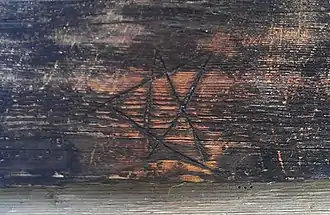Apotropaic mark
An Apotropaic mark or witch mark is a symbol or pattern scratched into the fabric of a building to keep witches out. It should not be confused with a witches' mark, which is a mark made by a witch.

Marks on buildings
Apotropaic marks (from Greek apotrepein "to ward off" from apo- "away" and trepein "to turn") are symbols or patterns scratched into the fabric of a building with the intention of keeping witches out through apotropaic magic.[1] Evil was thought to be held at bay through a wide variety of apotropaic objects such as amulets and talismans against the evil eye. Marks on buildings were one application of this type of belief.[2]
Marks have been found at Knole House, at Shakespeare's Birthplace in Stratford-upon-Avon, at the Tower of London,[3] and many churches, but little effort has been made to find them on secular buildings.[1] The marks are most common near places where witches were thought to be able to enter, whether doors, windows or chimneys.[1] For example, during works at Knole, near Sevenoaks in Kent, in 1609, oak beams beneath floors, particularly near fireplaces, were scorched and carved with scratched witch marks to prevent witches and demons from coming down the chimney.[4][5] At the Bradford-on-Avon Tithe Barn, a flower-like pattern of overlapping circles is incised into a stone in the wall.[1] Similar marks of overlapping circles have been found on a window sill dated about 1616 at Owlpen Manor in Gloucestershire, as well as taper burn marks on the jambs of a medieval door frame. The most recent and astounding collection of over 100 marks - previously thought to be graffiti - was discovered February 2019 in Creswell Crags, Notts, by Hayley Clark and Ed Waters of Subterranea Britannica during a tour of the caves. [6] Other types of mark include the intertwined letters V and M or a double V (for the protector, the Virgin Mary, alias Virgo Virginum), and crisscrossing lines to confuse any spirits that might try to follow them.[1][7]
See also
References
- Kennedy, Maev (31 October 2016). "Witches' marks: public asked to seek ancient scratchings in buildings". The Guardian. Retrieved 31 October 2016.
- Asuni, John. "Apotropaic Talisman Against the "Evil Eye"". Johns Hopkins Archaeological Museum. Retrieved 31 October 2016.
- "Tower of London staff 'used magic to repel the forces of the Devil'". The Independent. 16 October 2015. Retrieved 31 October 2016.
- Wright, James (19 October 2015). "Ritual Protection Marks and Witchcraft at Knole, Kent". Gresham College.
- Kennedy, Maev (2014-11-05). "Witch marks fit for a king beguile archaeologists at Knole". The Guardian. Retrieved 2014-11-05.
- "Cresswell Crags: Witches Marks Found In Cave Network".
- "Here Be Witchcraft". Lassco. 29 October 2014. Retrieved 31 October 2016.